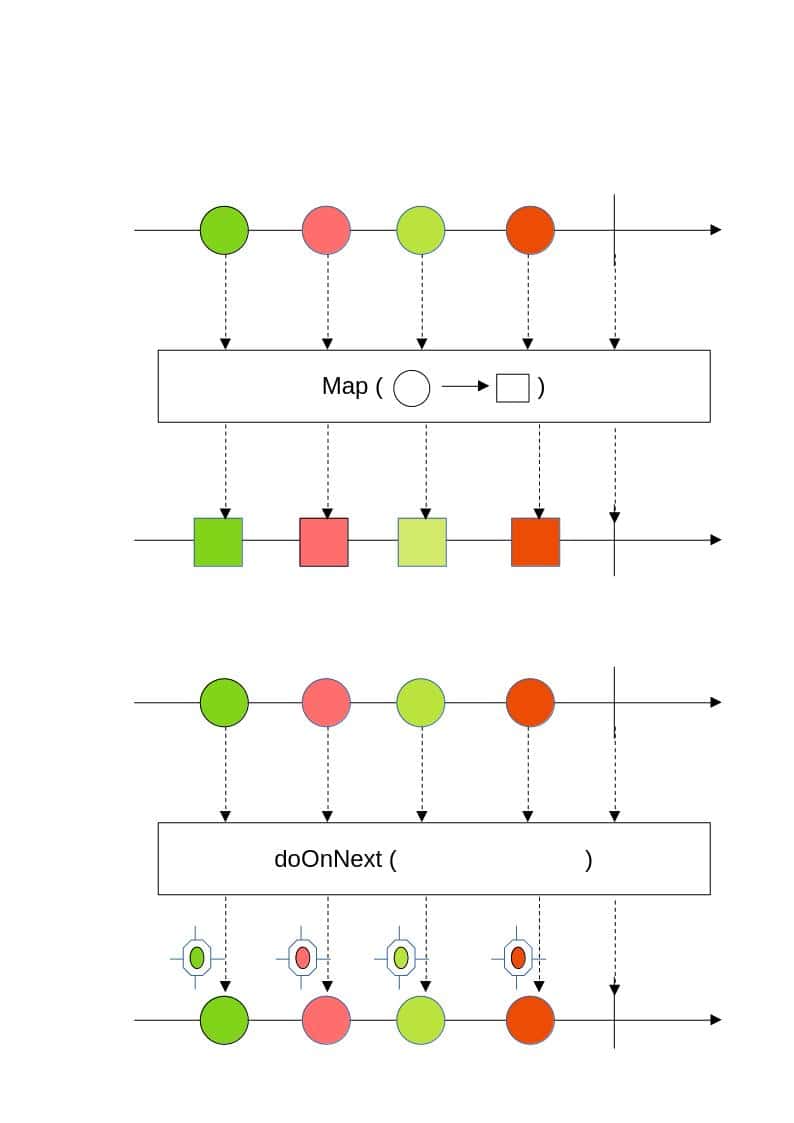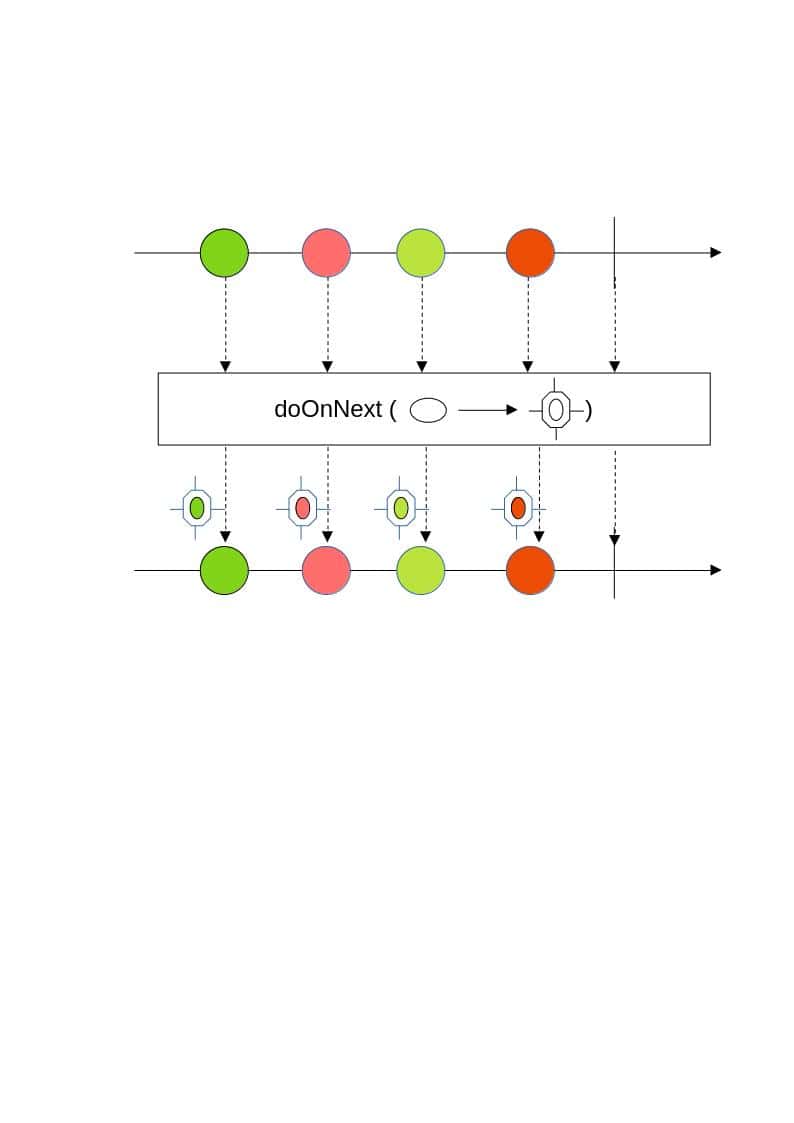1. 概述
在 Reactor 库 中,Flux.map() 和 Flux.doOnNext() 操作符在处理流数据元素时扮演不同角色。
Flux.map():用于转换Flux发射的每个元素Flux.doOnNext():生命周期钩子,可在元素发射时执行副作用操作
本文将深入剖析这两个操作符的内部实现和实际应用场景,并展示如何组合使用它们。
2. Maven 依赖
要使用 Flux 发布器和其他响应式操作符,需在 pom.xml 中添加 reactor-core 依赖:
<dependency>
<groupId>io.projectreactor</groupId>
<artifactId>reactor-core</artifactId>
<version>3.6.5</version>
</dependency>
此依赖提供 Flux、Mono 等核心类。
同时添加 reactor-test 依赖用于单元测试:
<dependency>
<groupId>io.projectreactor</groupId>
<artifactId>reactor-test</artifactId>
<version>3.6.5</version>
<scope>test</scope>
</dependency>
该依赖提供 StepVerifier 等测试工具类,用于创建测试场景并验证响应式管道行为。
3. 理解 Flux.map() 操作符
Flux.map() 与 Java 内置的 Stream.map() 类似,但作用于响应式流。
3.1. 弹珠图
通过弹珠图理解 Flux.map() 内部机制:

图中展示了一个无错误发射数据的 Flux 发布器,以及 map() 操作符对数据的影响:
- 操作符将圆形数据转换为方形
- 订阅后发射的是转换后的数据,而非原始数据
3.2. 方法定义
Flux.map() 接受一个 Function 参数,返回包含转换元素的新 Flux:
public final <V> Flux<V> map(Function<? super T,? extends V> mapper)
关键特性:
- 输入:
Flux发布器的数据流 mapper函数同步应用于每个发射元素- 输出:基于
mapper函数转换后的新Flux
3.3. 示例代码
将数据序列中的每个值乘以 10 进行转换:
Flux<Integer> numbersFlux = Flux.just(50, 51, 52, 53, 54, 55, 56, 57, 58, 59)
.map(i -> i * 10)
.onErrorResume(Flux::error);
验证发射的新序列是否符合预期:
StepVerifier.create(numbersFlux)
.expectNext(500, 510, 520, 530, 540, 550, 560, 570, 580, 590)
.verifyComplete();
map() 操作符按弹珠图和函数定义处理数据,生成每个值乘以 10 的新输出。
4. 理解 doOnNext() 操作符
Flux.doOnNext() 是生命周期钩子,用于窥探发射的数据流,类似于 Stream.peek()。它允许在不修改原始数据流的情况下对每个元素执行副作用操作。
4.1. 弹珠图
通过弹珠图理解 Flux.doOnNext() 内部机制:

图中展示了 Flux 发射的数据流以及 doOnNext() 操作符对数据的作用。
4.2. 方法定义
查看 doOnNext() 的方法定义:
public final Flux<T> doOnNext(Consumer<? super T> onNext)
关键特性:
- 接受
Consumer<T>参数 Consumer是表示副作用操作的函数式接口- 消费输入但不产生输出,适合执行副作用操作
4.3. 示例代码
使用 doOnNext() 在订阅时将数据流中的项目记录到控制台:
Flux<Integer> numberFlux = Flux.just(1, 2, 3, 4, 5)
.doOnNext(number -> {
LOGGER.info(String.valueOf(number));
})
.onErrorResume(Flux::error);
上述代码中,doOnNext() 记录 Flux 发射的每个数字,但不修改实际数值。
5. 组合使用两个操作符
由于 Flux.map() 和 Flux.doOnNext() 功能不同,可在响应式管道中组合使用以实现数据转换和副作用处理。
通过记录原始数据和转换后的数据来窥探数据流:
Flux numbersFlux = Flux.just(10, 11, 12, 13, 14)
.doOnNext(number -> {
LOGGER.info("Number: " + number);
})
.map(i -> i * 5)
.doOnNext(number -> {
LOGGER.info("Transformed Number: " + number);
})
.onErrorResume(Flux::error);
执行流程:
- 使用
doOnNext()记录Flux发射的原始数字 - 应用
map()将每个数字乘以 5 进行转换 - 使用另一个
doOnNext()记录转换后的数字
验证发射数据是否符合预期:
StepVerifier.create(numbersFlux)
.expectNext(50, 55, 60, 65, 70)
.verifyComplete();
这种组合方式在转换数据流的同时,通过日志提供对原始和转换元素的可见性。
6. 关键差异
两个操作符都作用于发射数据,但核心区别明显:
| 特性 | Flux.map() |
Flux.doOnNext() |
|---|---|---|
| 核心功能 | ✅ 转换操作符 | ✅ 生命周期钩子 |
| 数据修改 | ✅ 修改原始数据流 | ❌ 不修改数据 |
| 返回值 | 新的转换后 Flux |
原始 Flux(带副作用) |
| 典型用例 | 数据计算、类型转换、业务逻辑处理 | 日志记录、调试、监控、资源清理 |
⚠️ 简单粗暴记忆法:
map()= 数据变形器doOnNext()= 数据观察员
7. 总结
本文深入探讨了 Project Reactor 库中 Flux.map() 和 Flux.doOnNext() 操作符的细节,通过弹珠图、类型定义和实际示例剖析了它们的内部工作机制。
两个操作符服务于不同场景,组合使用可构建强大且健壮的响应式系统。实际开发中踩坑提醒:
- 避免在
doOnNext()中执行耗时操作(会阻塞响应式流) map()中抛出异常会中断流,需配合错误处理操作符
完整示例代码可在 GitHub 获取。